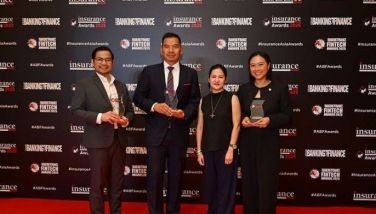Bridging worlds
October 15, 2005 | 12:00am
 Last September 30, I stood before a huge poster announcing: "Karim Rashid>The Beautiful, Shrinking World." Milo Naval, one of the vanguards of Movement 8, set up the event, together with Tony Gonzalez, another pillar of the group. In the last five years, Movement 8, together with Budji Layug and the late Eli Pinto, has brought Philippine-designed furniture to the forefronts of the world.
Last September 30, I stood before a huge poster announcing: "Karim Rashid>The Beautiful, Shrinking World." Milo Naval, one of the vanguards of Movement 8, set up the event, together with Tony Gonzalez, another pillar of the group. In the last five years, Movement 8, together with Budji Layug and the late Eli Pinto, has brought Philippine-designed furniture to the forefronts of the world.
Karim Rashid is among the best design practitioners in the industry, in a world that, in his words, "continues to shrink." With an awesome, 87-project package on his drawing board and more already being used by the global world, Rashid, in a modulated voice reminiscent of some late-evening radio deejay, took us from his beginnings to his current experiences.
While the debate about his style/design identity may not be entirely new, it nevertheless re-emphasizes the role that style or design takes. Design must be seen working beyond style in that it serves mankind in a more encompassing manner. Style dissipates in time, but often recurs in cycles. Achille Castiglioni, one of the revered designers of our times, argued that most of the best-designed products are those we almost forget as foreign objects because they have become so much a part of our domestic landscapes. Think about classic examples such as paperclips, toasters, or vacuum cleaners.
Karim takes a personalized approach. He dialogs to create a relaxed and casual atmosphere rather than a didactic delivery. He flashed images on screens merely as topical props. It was clever that Rashid opted to spare the audience from "how I tackled each project," and instead chose to create a picture of a world that keeps shrinking because of technology.
It also presents a somewhat fearful scenario, when robotics will replace human labor and when brain chips, allowing machines to open up into venues of exchange, will deprive us of real-life shopping and physical interface.
Rashid, being a citizen of a post-industrial society, confronts a landscape that puts a premium on efficiency and practicality. Here in a society such as ours, creative diversity is what is important. Therefore, going beyond the fear of a humanistic collapse to potent technology, Philippine designers could circumvent such a situation by taking skill as a counter-productive tool. Karim himself admits that it is not whether it is technologically made or hand-made that matters, because the bottom line is, good design is good design.
What is design? Rashid is almost exact in his definition, where he sees design as the shaping mechanism for the contemporary world. The shaping of tomorrow takes place with an idea taking place now. While he is a futurist in that he doesn’t look to the past but instead to the future, this is again more tactical than real. Design is a product of a continuing process. He envisions an automated world that enables movement and travel made easy, accessible to reach consumer wants.
Is Karim Rashid the right man we need for the progress of our industries? His perceptions might be too progressive for the current development taking place here. Some might even scrap the very core of many investments here: the shopping malls. Can you imagine shopping entirely through e-Bay?
I think it would be largely myopic to take his dialog literally. First, it seems paradoxical that he leaps away from the very core of his becoming involved with design – the sense of touch – which torches his beginnings. The other is that he articulates for the age of technology, when the production process has changed dramatically in the last few years. It is also clear that he knows very little of our culture, other than perhaps whatever information he was given about us. The body of his works may be broad and worldwide, but it largely addresses post-industrial societies; hence, it becomes almost unreachable for us at the moment. On the other hand, if we are to use Rashid’s convention of thinking linked with programs looking to a progressive future, then his intentions should prepare us to think about the inevitable.
Ten years ago, I attended a similar event hosted by the Philippine Design Center, where an English visitor made a somewhat disturbing analogy about China. Instead of dealing with design per se, China chose to buy and invest in machines. China has the largest population in the world, and it had more to lose by leaving a billion people without work, but their hunch to turn to machines and manage a set of programs that would make them viable to this date appears to be a clever switch. When local manufacturers asked Rashid if we have a design edge over China because our products are made by hand, Rashid was emphatic and candid: automate or it will become too costly to do so if we are to wait further.
I agree with Rashid that turning to automation does not impede the use of humans; rather, while we may not be using human hands, we gain more from developing human minds. Or, at best, it only speeds things up, meeting competitive delivery schedules.
A similar question came up at the start of the ’90s, about whether or not by turning to a digitized perspective, architects would lose the worth of their profession because computers would replace production work. Today, 15 years later, architecture has been propelled to newer and greater heights because it has used technology as a collaborative ally rather than an enemy. In fact, the Architectural Association School of Architecture has a Design Research Lab aimed at "merging architecture with non-organic forms of life to create increasingly immersive and interactive environments." In the AD 2004 issue on "Back to School," university heads in architecture predict that digitized technology will become a basic tool in architectural programs of education.
In a country that sends hundreds of engineers to different parts of the world, don’t you ever wonder why engineering design here has not propelled progressive ideas to create machines for daily use? Early in his talk, Rashid joked about how whenever he asked for drinking water, he was offered bottled water from another country. His point was that one does not need pseudo-status for a basic commodity like water, if only more creative packaging is done. He was saying that product creativity must start at home.
Rashid echoes the fact that technology is, in fact, humanizing in that it serves to link people closer.
While there are obvious gaps between more advanced societies and ours, it is not farfetched that we should be able to reach the same quality of results that creative professionals such as Rashid are doing. In our own way, parallel growth can be attained even when using low technologies as long as our viewpoints are deep and passionate. We must be competitive but prepared to level down our egos and live with our peers as allies. The design community here can only prosper when we are truly united in our desires to make our country a better place to live in.
The July 25 issue of Newsweek was a special issue dedicated to the Good Life. There were at least three major features that struck me as being relevant to us: "Made by Hand" by Christopher Dickey and Anna Kuchment, "Rustic Luxury" by Carla Power, and "Maximum Luxury" by Rana Foroohar. These articles state that imagination should provide the next response.
In all, Rashid clearly portrayed the culture of thinking in advanced societies. For all it’s worth, it exposes reality in terms of how we should be able to think beyond the sphere we are in. Because the world has figuratively shrunk its barriers rather than offering a wider arena of competition, we can aim for being involved in the flow that our world is opening up. Rashid is brutally frank about the world he knows, and his world is not far different from our world. It is up to us to interpret our choices of action.
Lastly, should we have more of these kinds of forums taking place? One of the best features in some advanced university programs abroad are weekly forums with different speakers who share their work views. I have been told that in our case, funding luminaries to visit us is the problem – we are miles away from their itineraries. However, I believe there are many visionaries out there who would willingly share their passion for the sake of a good cause. "Every nation is a beautiful, shrinking world." It has more sense and meaning to me now than just a play of words.
BrandSpace Articles
<
>




















